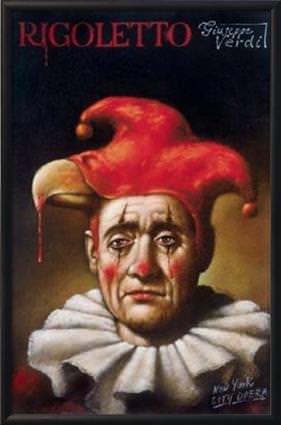Painted Red

http://reason.com/assets/mc/_ATTIC/tcavanaugh/rigoletto.jpg
As the curtains drew open and fell into an elegant drape, they revealed vibrant colors and pure merriment that accompanied the mood introduced by the orchestra. Watching the scene unfold was like watching a masterful painting reworking itself seamlessly and beautifully. There was a feeling only the Metropolitan Opera could give a person, that they were transported somewhere completely different to enjoy an art of a different age. I’ve never truly appreciated opera and have often fallen asleep during them. The smooth movement and seemingly never-changing singing used to wear on my eyes and ears and draw me into a deep lull. When I was young, I would be woken up with the sound of my aunt’s voice (a choreographer who took me to some shows and rehearsals); the night of Rigoletto, I was determinedly staying awake helped by the gentleman snoring loudly next to me.
Perhaps it was because I actually knew the plot of the opera that made it more interesting to see; knowing what’s going to happen allows one to be entranced by the costuming, set, music, and emotion. From a vibrant set in Act I to the darker set of Acts II and III, a warm, burgundy material was prominent in the costumes of the Duke, Rigoletto, Gilda’s nurse Giovanna, and Countess Ceprano. The color seemed to be symbolic of the curse and the pain the Duke causes; the Countess Ceprano is representative of the Duke’s disrespect for women, their significant others and relatives and Giovanna is representative of her inability to successfully care for her charge. Rigoletto wears quite a bit of the burgundy in his jester outfit, but in the next scene where he meets Sparafucile, he only wears a small cape of the color. As soon as he enters the house, it is removed and alternately placed around his daughter and himself. Maybe it wasn’t intentional, but an interesting detail to explore.
Aside from the costuming, George Gagnidze’s portrayal of Rigoletto was so powerful and I was unaware of his illness during the performance. The voice and acting of the Duke was quite commendable as well. I was pleasantly surprised by Gilda’s piercing voice which by the end had an eerie but enjoyable ring. I found Sparafucile’s voice to be the most impressive; it had power but sweetness to it that fit his cunning and vicious role in the play.
I stayed awake the whole opera, my eyes following the subtle movements of the dresses, then the exchange between father and daughter, and the final bit of the curse as the actors ran around the set; if only I could have heard the music without the accompaniment of deep inhales and exhales. However, the grandeur and feeling provided by the orchestra, the set, the singing, the actors, and the entire production made it worthwhile. The curtains were drawn down as gracefully as they were opened to mark the end of a picturesque production.

